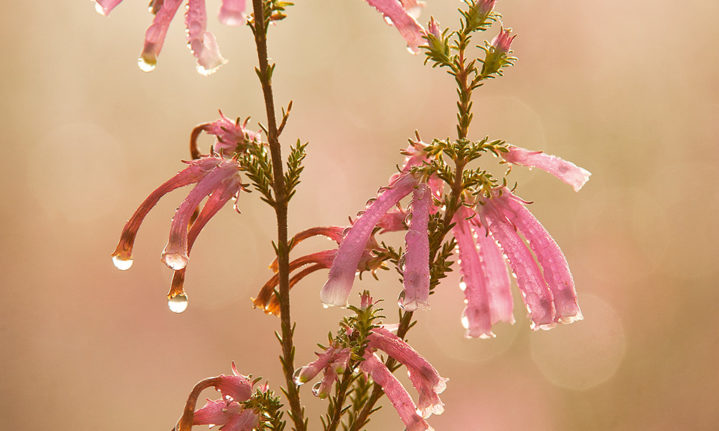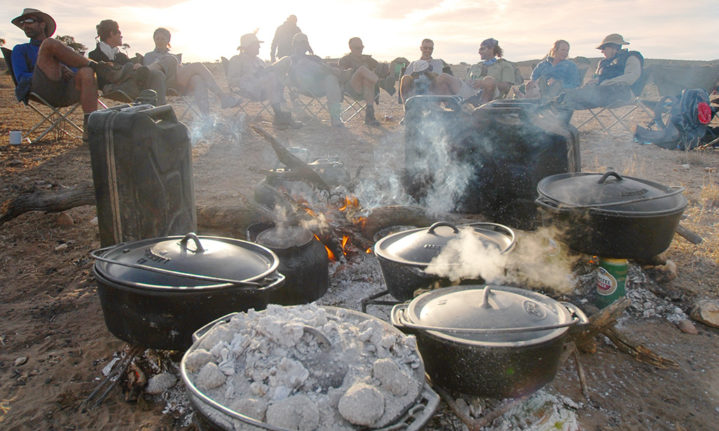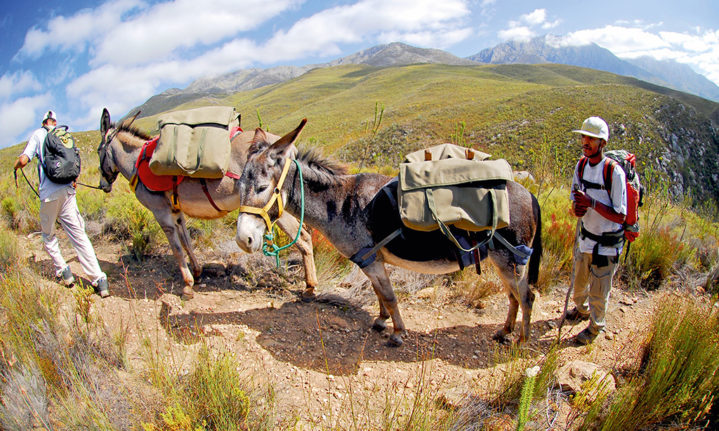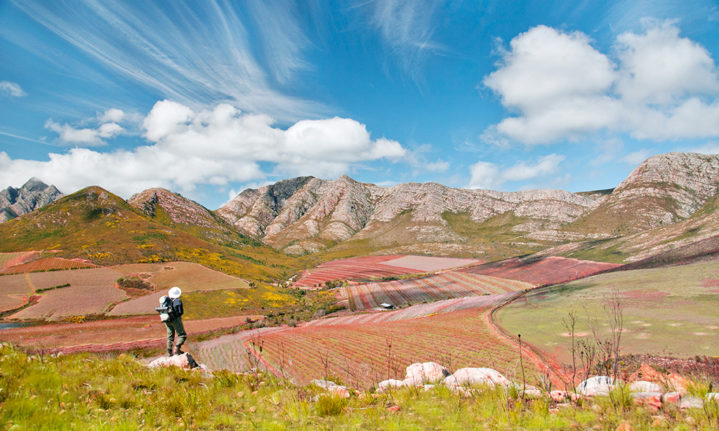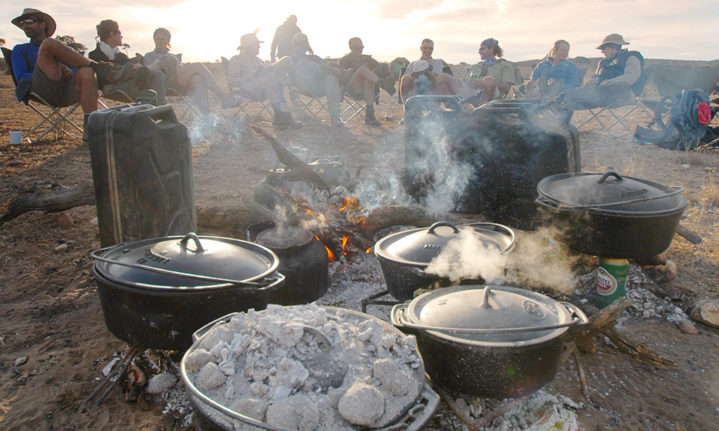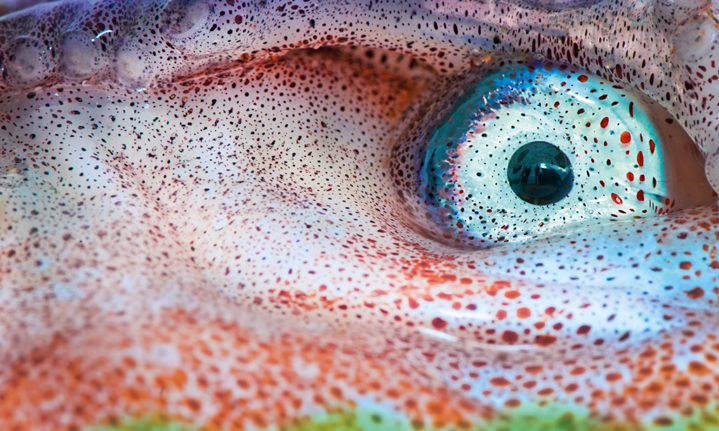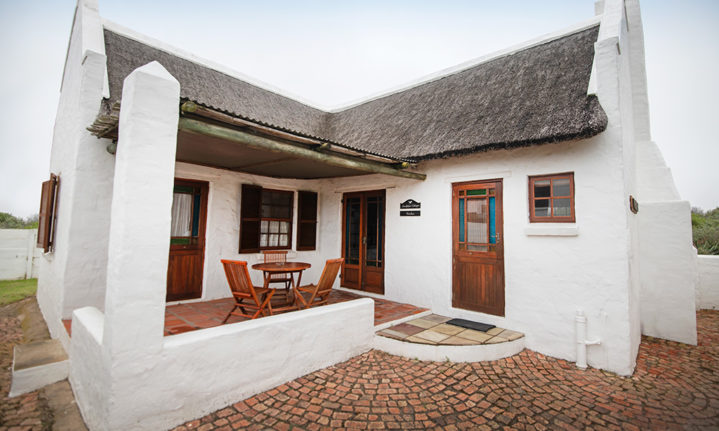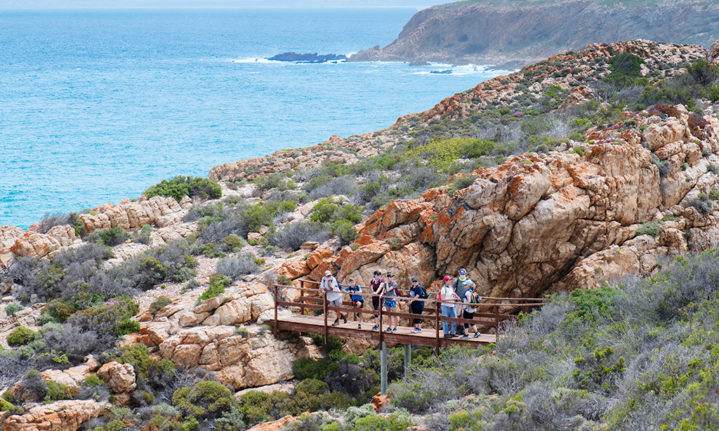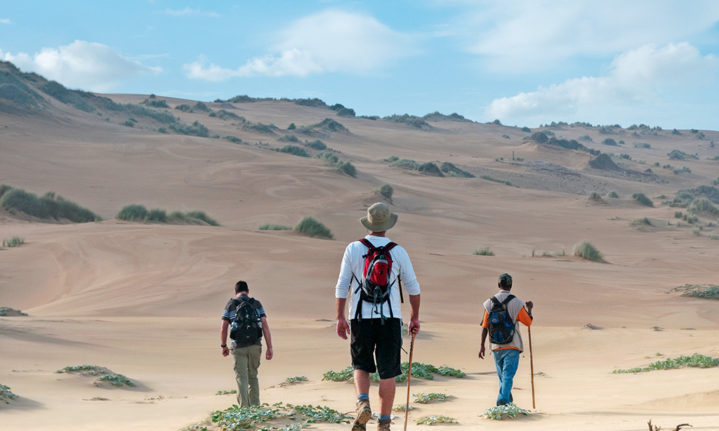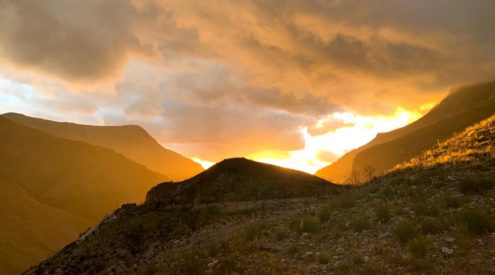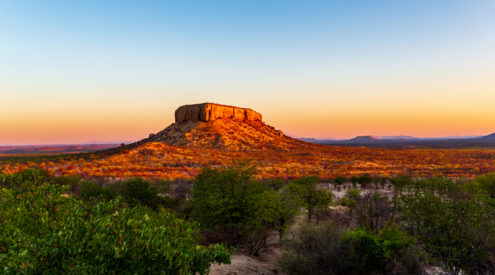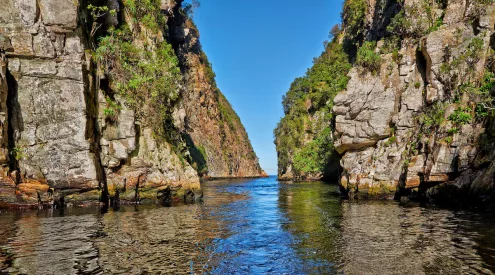Along the Oystercatcher Trail and other multi-day treks, hikers are taking to nature without having to carry the world on their shoulders
Words & Photos Dale R Morris

Dinner is prepared on an open fire for tired hikers during the 350km Eden to Addo mega hike.
Standing atop a red stone cliff near Mossel Bay, the sea a sapphire turmoil below, my fellow hikers and I scanned the horizon for spouts of whale breath. ‘There’s one,’ pointed Chris Carr, our encyclopaedic guide. ‘It’s most likely a humpback at this time of year.’
And indeed it was.
There were also dolphins in the waves, and a lone seal who appeared to be larking around in the swell just for the fun of it.

The Oystercatcher Trail from Mossel Bay traverses wild and empty beaches backed by sand dunes and coastal cliffs.
‘Okay, shall we continue? ’This was day one of the Oystercatcher slackpack trail; a fully catered and guided ramble, starting at Mossel Bay and ending four nights and some 45km later at the Gouritz River Mouth. En route, we would hug some of the prettiest sections of coastline in the Western Cape, ambling along clifftop paths while traversing empty beaches with nary a soul in sight. We would encounter octopi and oystercatchers, dassies and falcons, and through our guide’s local knowledge, we would also learn about the history of the area, some of it recent, some of it so ancient as to pre-date the very existence of our species.
‘Ahh, but this is slackpacking at its best,’ said my 14-year-old son from the balcony of our private cottage overlooking the sea in the little village of Boggoms Bay. He was sipping on a cold drink and massaging his feet against the day’s new blisters.
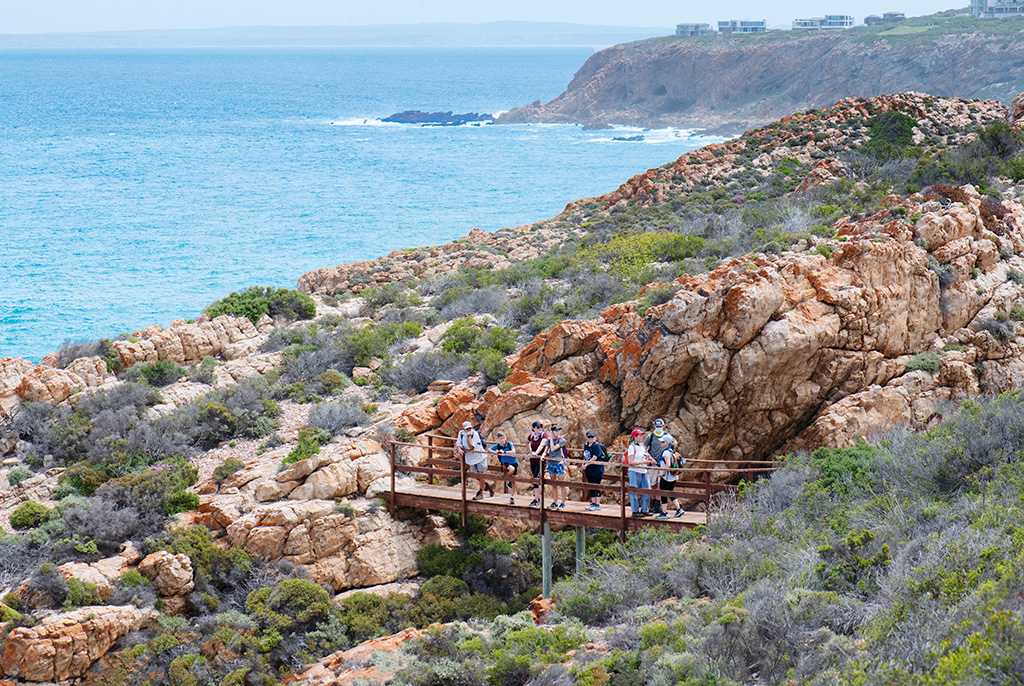
Day one of the Oystercatcher Trail; expect encounters with seals along the coastal route
‘How many kilometres did we do?’
‘Just nine,’ I told him.
We could have done all 14. I wanted to. But upon reaching an escape point on our path, my son, along with a few other trail participants, decided they were satisfied for the day.
Being picked up by a vehicle when the calves go on strike, having cold drinks delivered, and being taxied back to your cushy accommodation are just some of the perks of slackpacking. And there are many, many more.
I’m sure we can all agree that getting out into nature is good for you; and perhaps walking is one of the best ways, if not the best way, to take it all in at a slow and passive pace. But not all of us are able to easily traverse those boundless kilometres. Past hikers who now have dodgy knees, older folk, small children, and bone-idle teenagers; those of us who are unfit or pudgy, and nervous folk who sense danger round every corner. We may wish to head out on foot on a grand trek but maybe it seems too much of an ominous task. We know it would be fun, but perhaps we lack the confidence.
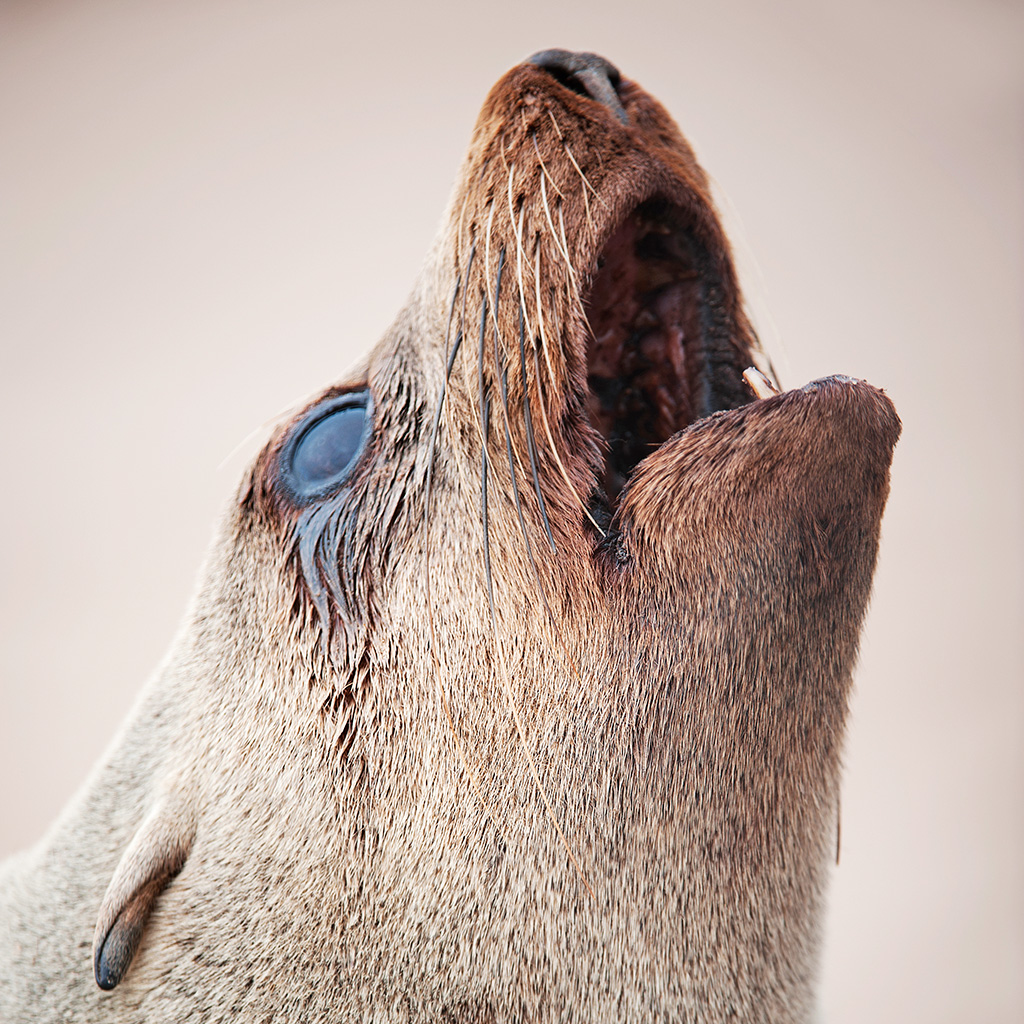
Expect encounters with seals along the coastal route
What if something goes wrong?
Cue: slackpacking trails, of which there are numerous choices in this beautiful country of ours.
Typically, there will be a guide on hand, not only to translate what we are seeing into stories and meaning but also to assure our safety and to lead us down the right paths where we might otherwise take a wrong turn. Chris Carr, of the Oystercatcher Trail is an absolute goldmine of information. He has a caring demeanor, an easy charm that fills you with wonder for the environment through which we walk. He also inspires confidence. Every slackpack trail has a Chris Carr equivalent: and they tend to be really nice people.

Dolphins larking in the surf are a common sight along Western Cape coastal trails
Another serious plus for slackpacking versus DIY multi-day hikes is having your meals cooked for you; as is sleeping in a real bed rather than in a hikers’ hut or on a roll mat on the floor of a tent. But perhaps most importantly of all is the godsend of not having to carry a horrendous backpack full of clothes, dried noodles and camping gear.
Luggage stays at base camp (as is the case on the Oystercatcher Trail) or else it is portaged between nightly destinations. All that’s left for you to do is hike free and easy with no concerns for any of the logistics. It’s bliss. Absolute bliss.
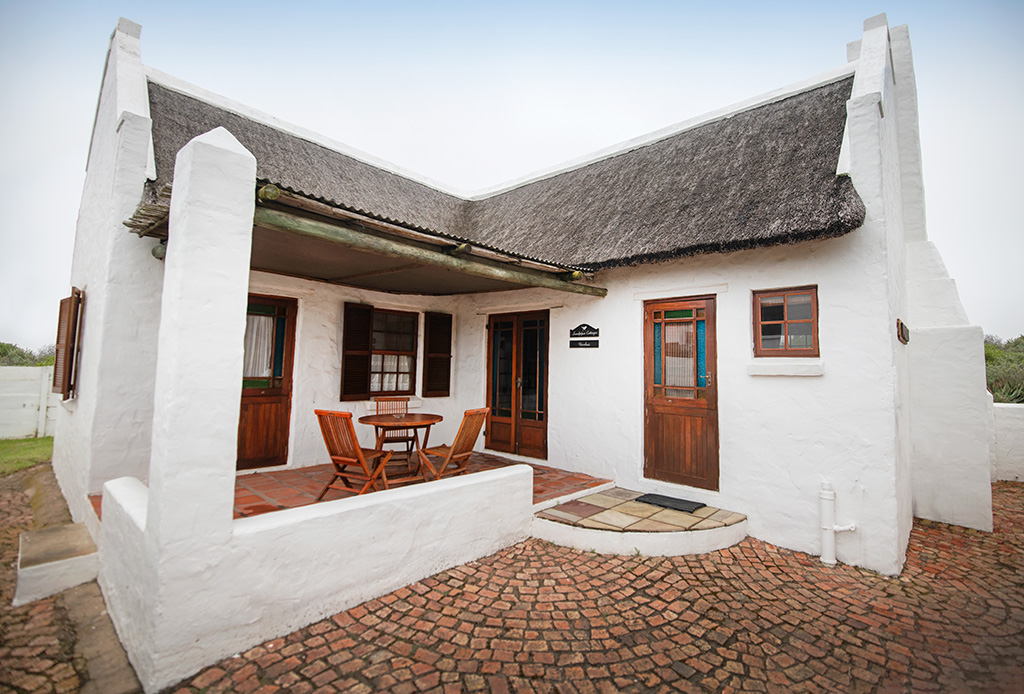
No more bunk beads and roll mats – this slackpack accommodation in Boggoms Bay is cosy and of a high standard.
So, there we were on day two of the trail, slightly stuffed after consuming a hearty breakfast, walking barefoot along the wide long curve that is Vleesbaai. Oystercatchers scuttled along in front of us like clockwork toys, picking at morsels washed up by the sea. Large jellyfish, marooned on the tideline, became prey to thousands of sail-footed snails. This was not hardcore hiking. More like a semi-sedate ramble accompanied by Chris’ fascinating commentary.
‘Translated to English, this place is called Flesh Bay,’ he informed us as we walked. Sounds a bit like a red light district, I thought to myself, but Chris went on to explain that way back in 1601, a Dutch trading vessel was forced to seek shelter from a storm here.
‘They came ashore and met with a clan of native Khoi who were happy to trade meat for western trinkets.’ Burgers for beads… and fresh water, too.

Professional guide, Chris Carr leads slackpackers along an idyllic beach on the Oystercatcher route
‘But that is a recent history compared to what we see here.’ We had detoured from the beach and into rolling dunes where middens of shells (the cast off detritus from our Stone Age ancestors) are as common as the sand in which they are found. He picked up a large diamond-shaped rock and passed it around.
‘This is an Acheulean hand axe,’ he told us. ‘It could be more than a million years old.’
That would make it older than the homo sapiens species itself; and as I held it in my own hands, I became awed at the thought of who, or what, pre-hominid ancestors fashioned this tool.
Such artifacts from both ancient humans and our pre-human ancestors litter this area.
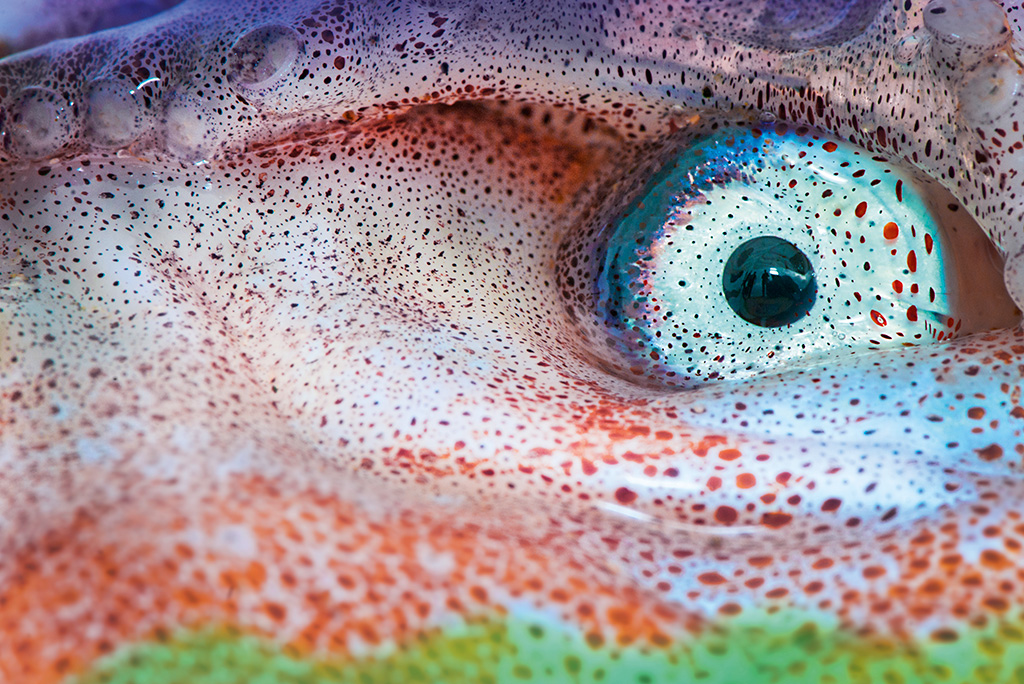
Eye of the beholder – a rare paper nautilus washed ashore at Vleesbaai.
The final day of the hike was a big push, 21km of empty beaches and rocky coves, finally culminating with a river crossing to the small village of Gouritzmond. Along the way we saw prehistoric, man-made fish traps and yet more evidence of ancient peoples littering the sands, and it made me reflect on what the world might have looked like all those millennia ago.
Then we paused to take in all that surrounded us. The beach was empty and wild, the dunes soared above and the coastal fynbos swayed fragrantly in the breeze.
‘I don’t suppose it’s really changed all that much,’ said Chris.
Slackpacking is all about immersing yourself into the landscape; a way of getting to know the nature, the wilderness, the wildlife and the history of a place. And once you finish those kilometres, sore feet and all; you can sit back, enjoy a sense of achievement, drink a cold one and share a meal with new friends served up by your cordial hosts.
…And then plan your next slackpack hike.
Dale’s top slackpacking trails in the Eastern and Western Cape
South Africa is home to scores of commercially run routes which offer a fully catered service including lodgings, meals, transport and professional guides. Get more information at slackpacker.co.za where you can organise and book numerous existing trails all over SA. You can even create a tailored slackpack experience from non-slackpack routes. Another good resource, listing 30 top trails, is dirtyboots.co.za. The following are my picks:
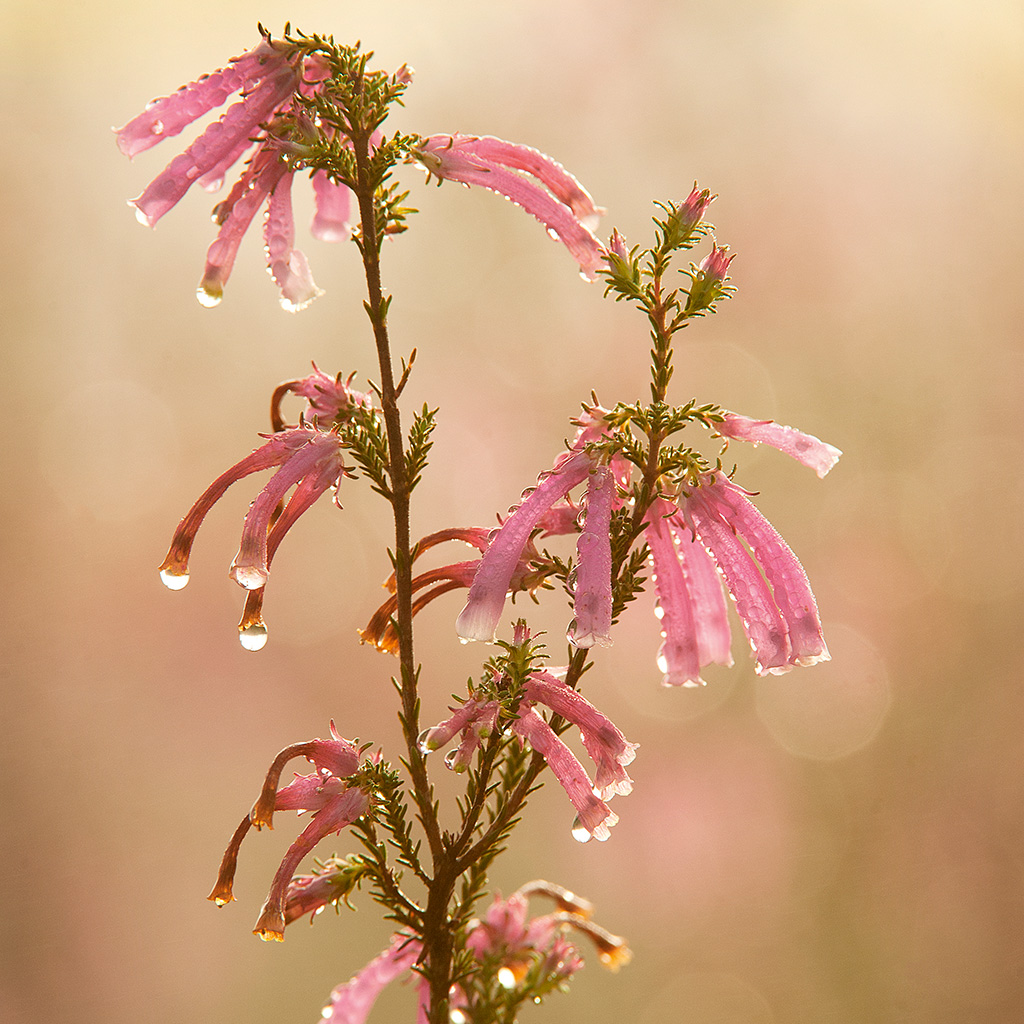
Colours of fynbos – many little details like this go unnoticed without an expert nature guide.
The Oystercatcher Trail
A coastal trail with an emphasis on nature and ancient history.
Where: Mossel Bay to Gouritzmond, Western Cape
Distance: 45km
Duration: Four nights, five days. Overnight: Self-contained ‘base camp’ cottages in Boggoms Bay.
Cost: From R7 500pp
082 078 1696, oystercatchertrail.co.za
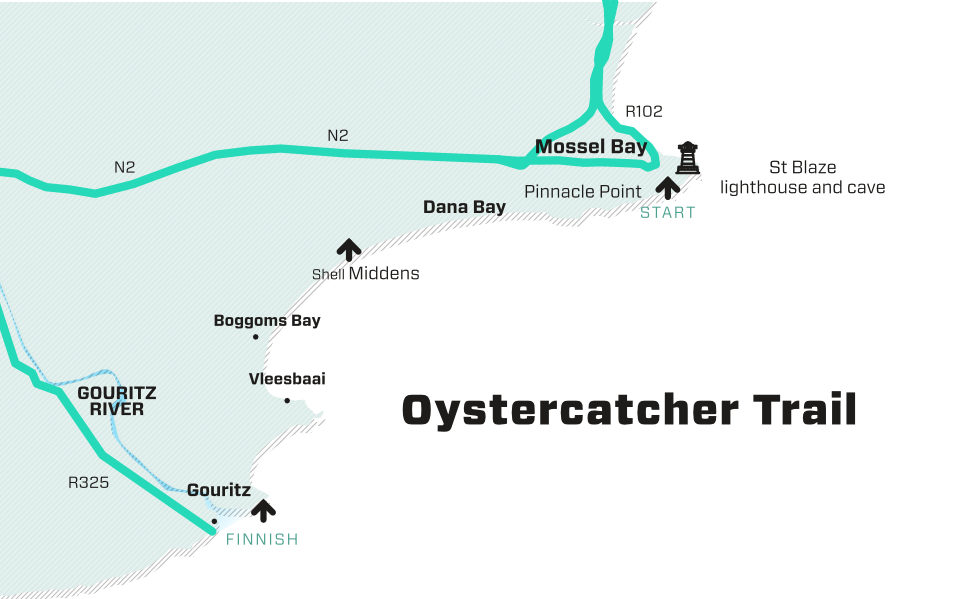
The Plett Trail
A varied trail with forests, beaches, nature reserves, coastal views and mountains. You’ll visit the beautiful Nature’s Valley area, hike wild and empty beaches and trek the entirety of the Robberg Peninsula where seals and sharks abound.
Where: Plettenberg Bay, Western Cape
Distance: 37km Duration: Four nights, five days
Overnight: Luxury safari tents with beds and showers in a static camp near Plett.
Cost: R6 750pp if glamping R9 250pp with Plett-based lodging
044 535 9033, venturebeyond.co.za

Hiking without a pack is a dream and eats up the first day’s cliff-top kilometres with little schlep.
The Chokka Trail
Sharing some similarities with the Oystercatcher Trail, the Chokka Trail will take you along empty breaches and through desert-like dune fields where evidence of prehistoric hominid and human settlements are easily encountered. An expert guide will regale you with stories of cavemen, Strandlopers and settlers. There’ll be dolphins, seals and otters as well.
Where: Oyster Bay to Cape St Francis, Eastern Cape
Distance: 62km (18 of which are optional)
Duration: Three nights, four days
Overnight: Different upmarket lodges along the route.
Cost: From R5 770pp
073 825 0835, chokkatrail.co.za

Expect to find beautiful scenery around Vleesbaai and Boggoms Bay on day two of the hike.
The Donkey Trail
During the 1830s, trekboer pioneers discovered and settled in a lush hidden valley atop the Swartberg Mountains. They had no roads in and out and instead used donkey caravans to transport their produce to market via a steep zigzaging mountain path. Accompanied by your ‘rented’ donkey, you will follow the same route as those early isolationists and even get to sleep in their restored historical homes.
Where: Swartberg Nature Reserve, Klein Karoo, WC
Distance: 26km (nine optional)
Duration: Three nights, three days
Cost: From R6 500pp
Overnight: Various different places along the route each night.
073 593 4007, donkeytrail.com
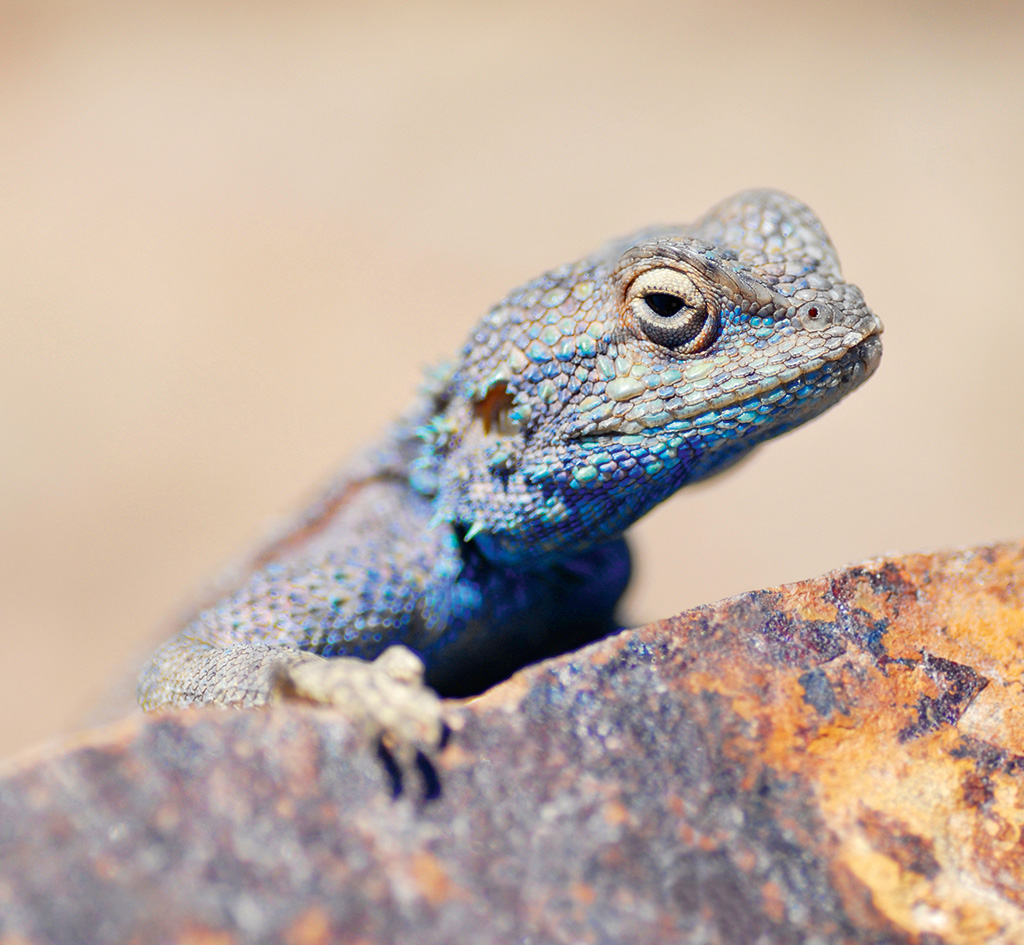
An agama lizard watches suspiciously as hikers traipse past his rock
Garden Route Trail
A predominantly coastal tour of some of the Garden Route’s nature reserves hosted by Mark Dixon, an expert Marine Biologist and naturalist. It’s a beautiful hike by itself but with Mark and his gargantuan brain along to educate and enlighten, you are bound to learn many amazing things about the natural history of the area.
Where: From Wilderness to Brenton on Sea ,WC
Distance: +/- 60km including canoe sections and loop excursions
Duration: Four nights, five days
Cost: From R8 500pp
Overnight: SANParks and Cape Nature lodges.
082 213 5931, gardenroutetrail.co.za

Robberg Peninsular, Plett Trail
Eden to Addo
Not for the faint of heart, it’s an annual trek starting near Knysna and ending in the Addo Elephant National Park. Traversing the Knysna forests, the Tsitsikamma mountains, Baviaanskloof wilderness and Addo, this charity funding NGO trail is an absolute ultimate and crosses some of the most untouched and wild areas in South Africa.
Where: Western and Eastern Cape
Distance: Roughly 350km
Duration: 21 nights, 20 days in September this year.
Overnight: Safari tent camps are set up in a different location every night.
Cost: R35 000 (minimum donation)
044 533 1623, edentoaddo.co.za

Tsitsikamma Mountains, Eden to Addo Trail
Other slackpack trails
KZN
Drakensberg Giants Castle trail
giants-castle.co.za
Northern Cape
The Namaqua Silver Sands trail
namaquasilversands.co.za

Donkey Trail, Klein Karoo
Limpopo
Big Five Kruger Pafuri walking safaris
returnafrica.com
And for something different you can do a multi-day horse ride and/or hike into Lesotho with khotso.co.za; or similar trail in the Baviaanskloof mountains with baviaanscamino.com









